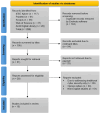Evolving Zero Trust Architectures for AI-Driven Cyber Threats in Healthcare and Other High-Risk Data Environments: A Systematic Review
- PMID: 40625466
- PMCID: PMC12229833
- DOI: 10.7759/cureus.85446
Evolving Zero Trust Architectures for AI-Driven Cyber Threats in Healthcare and Other High-Risk Data Environments: A Systematic Review
Abstract
The rapid adoption of artificial intelligence (AI) in healthcare and other high-risk environments has introduced sophisticated cyber threats that challenge traditional security models. Zero Trust Architecture (ZTA), with its principle of "never trust, always verify," has emerged as a promising framework to counter these evolving risks. This systematic review examines the current state of ZTA implementations in mitigating AI-driven cyber threats, focusing on healthcare systems, and identifies gaps between theoretical principles and real-world applications. Following the Preferred Reporting Items for Systematic Reviews and Meta-Analyses (PRISMA) 2020 guidelines, we conducted a comprehensive search across five databases (IEEE Xplore, PubMed, Scopus, Web of Science, and ACM Digital Library), identifying 299 records. After removing duplicates and screening for relevance, 15 studies met the inclusion criteria. These studies were analyzed for themes related to ZTA components, AI threat mitigation, implementation challenges, and ethical considerations. The Mixed Methods Appraisal Tool (MMAT) was used to assess methodological quality and risk of bias. The review revealed that while ZTA principles are well-suited to address AI-driven threats, particularly through explainable AI (XAI) and continuous monitoring, significant gaps persist in standardization, empirical validation, and stakeholder trust. Key findings include (1) a lack of metrics to evaluate ZTA efficacy against adversarial AI; (2) ethical and regulatory hurdles, such as algorithmic bias and data privacy concerns; and (3) operational barriers like interoperability issues and clinician resistance. Only four of the 15 studies provided real-world evidence of ZTA implementations, highlighting a critical research-practice divide. ZTA represents a transformative approach to cybersecurity in AI-augmented environments, but its potential remains underutilized due to theoretical dominance and implementation challenges. Future efforts must prioritize interdisciplinary collaboration, standardized frameworks, and pilot studies to bridge these gaps. Without actionable advancements, ZTA risks being outpaced by the very AI threats it seeks to mitigate. This review underscores the urgent need for adaptive, evidence-based ZTA models tailored to high-risk sectors, such as healthcare.
Keywords: ai-driven cyber threats; explainable ai; healthcare cybersecurity; systematic review; zero trust architecture.
Copyright © 2025, Zakhmi et al.
Conflict of interest statement
Conflicts of interest: In compliance with the ICMJE uniform disclosure form, all authors declare the following: Payment/services info: All authors have declared that no financial support was received from any organization for the submitted work. Financial relationships: All authors have declared that they have no financial relationships at present or within the previous three years with any organizations that might have an interest in the submitted work. Other relationships: All authors have declared that there are no other relationships or activities that could appear to have influenced the submitted work.
Figures
Similar articles
-
AI for IMPACTS Framework for Evaluating the Long-Term Real-World Impacts of AI-Powered Clinician Tools: Systematic Review and Narrative Synthesis.J Med Internet Res. 2025 Feb 5;27:e67485. doi: 10.2196/67485. J Med Internet Res. 2025. PMID: 39909417 Free PMC article.
-
The Role of AI in Nursing Education and Practice: Umbrella Review.J Med Internet Res. 2025 Apr 4;27:e69881. doi: 10.2196/69881. J Med Internet Res. 2025. PMID: 40072926 Free PMC article.
-
Influence of Human Factors on Cyber Security within Healthcare Organisations: A Systematic Review.Sensors (Basel). 2021 Jul 28;21(15):5119. doi: 10.3390/s21155119. Sensors (Basel). 2021. PMID: 34372354 Free PMC article.
-
The Impact of Artificial Intelligence on Financial Systems in Healthcare: A Systematic Review of Economic Evaluation Studies.Cureus. 2025 Jun 18;17(6):e86279. doi: 10.7759/cureus.86279. eCollection 2025 Jun. Cureus. 2025. PMID: 40688959 Free PMC article. Review.
-
Trust in Artificial Intelligence-Based Clinical Decision Support Systems Among Health Care Workers: Systematic Review.J Med Internet Res. 2025 Jul 29;27:e69678. doi: 10.2196/69678. J Med Internet Res. 2025. PMID: 40772775 Review.
References
-
- Understanding healthcare cybersecurity risk management complexity. Burrell DN. Land Forces Acad Rev. 2024;29:38–49.
-
- Zero-trust architecture for cloud-based AI chat applications: encryption, access control, and continuous AI-driven verification. Mubeen M. https://urn.fi/URN:NBN:fi:amk-2024121937601 Theseus. 2024
-
- Towards secure and trusted AI in healthcare: a systematic review of emerging innovations and ethical challenges. Khan MM, Shah N, Shaikh N, Thabet A, Alrabayah T, Belkhair S. Int J Med Inform. 2025;195:105780. - PubMed
-
- The significance of artificial intelligence in zero trust technologies: a comprehensive review. Ajish D. J Electr Syst Inf Technol. 2024;11:30.
-
- Blockchain-powered cyber-resilient microservices: AI-driven intrusion prevention with zero-trust policy enforcement. Kaul D. J Math Comput Sci. 2019:1–34.
Publication types
LinkOut - more resources
Full Text Sources
Miscellaneous

